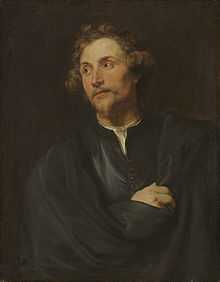Georg Petel

Georg Petel (1601-2 – January 1635) was a sculptor of the Early Baroque period and a European ivory carver.
Petel was born in Weilheim, Bavaria, around forty kilometres south-west of Munich, the son of Clement Petle (or Betle -alternative spellings), a cabinetmaker. He grew up an orphan as both his parents died when he was a small child. Bartholomäus Steinle, a local carver, became his guardian and was his first trade master. Petel learned ivory carving in the court cabinet-making studio of Christoph Angermair in Munich. At the beginning of the Thirty Years' War, he left Germany and became an itinerant craftsman. In 1620/21 he met Peter Paul Rubens in Antwerp who was an important influence. He later travelled via Paris to Rome and Genoa, where he was considered the greatest ivory carver of the time. Georg Petel died from the plague in Augsburg at the age of only thirty four.
During the Counter Reformation, Georg Petel created many crucifixes, with original designs and special features. He carved the ivory crucifix, discovered recently at the Carmelite convent in Pontoise, when he was in Paris in 1621 at the age of just nineteen. His mastery of difficult motif is an expression of his genius.
Petel also created figures of saints especially Saint Sebastian, the patron saint of the plague. He chose subjects from mythology and pioneered an earthy eroticism in his treatment of these subjects.
Examples of his work can be found in the Kunsthistorisches Museum, Vienna; the Residenz Museum, Munich; St. Moritz Church, Augsburg and the Bavarian National Museum (Bayerisches Nationalmuseum) in Munich.
Biographical timeline
1601/02 born in Weilheim, forty kilometres south-west of Munich, the son of Clement Petle, a cabinetmaker.
Prior to 1620 Apprenticed to Bartholomäus Steinle Weilheim a local carver.
Around 1620 Studied in Munich under Christoph Angermayr where he is thought to have first carved ivory.
1620/1625 Travelled to Antwerp where he became friends with both Peter Paul Rubens and van Dyck. Later he went on to, Paris, Rome and Genoa.
1625 The "Magdalena am Kreuzesstamm" in the Niedermünster at Regensburg
1625 Established himself in Augsburg, Bavaria where he created numerous works including: the second labour of Hercules, a salt barrel showing the Triumph of Venus, statues of St. Sebastian and also St. Chritopher in St. Moritz Church, Augsburg (1628). A Bacchanale in ivory (1630/33) and Statue of the child Jesus (1632),
Biographical works (German)
Georg Petel by Leon Krempel
Georg Petel: Barockbildhauer zu Augsburg von Alfred Schädler, Eva Langenstein, und Peter Volk (1985)
Georg Petel von Theodor Müller und Alfred Schädler (Published - 1964)